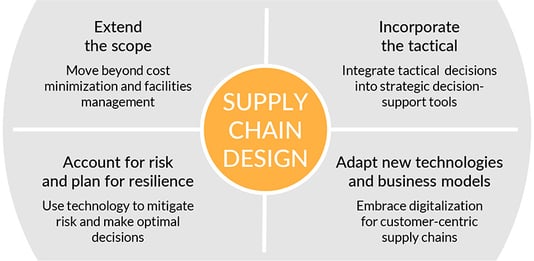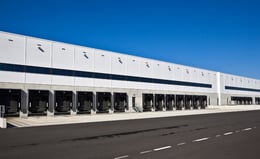6 Great Ideas Nail Down Supply Chain Tech Success
Keith LaBotz - August 04, 2022

“If all you have is a hammer, everything looks like a nail” - Abraham Maslow.
Imagine bringing a hammer to fight a wildfire. Now you understand how ineffective new technology is for many companies battling the supply chain wildfire.
These companies are doing everything right but can’t understand why the new tools aren’t meeting expectations. This problem is more widespread than most realize, and chances are, your company is facing the same challenge.
80% of organizations are pursuing supply chain digitalization to increase agility, yet only 30% of these projects will succeed. This high failure rate is not for lack of excellent technology, resources, or user training. The problem and its solution are much more straightforward - how we think.
The problem is that many companies are using the right tools for the wrong job. Sticking with proven methods is reasonable, so businesses don’t change how they think about the supply chain when new technology arrives. Teams continue hammering away at challenges with the same understanding, and new technology is viewed as a shinier, faster hammer.
The results are usually disappointing when a tool is used to do a job it wasn’t designed for. No wonder Gartner reports companies are burning with regret over technology purchases, but traditional methods are no longer effective with supply chains.
A recent white paper published by the MIT Center for Transportation & Logistics provides a remedy that points to supply chain design. It identifies four primary opportunities for leveraging the latest supply chain design methods and practices.

Quelle: 2022 MIT Center for Transportation & Logistics
These four areas reflect flexis AG's approach to optimizing supply chain processes. Optimization is more about designing the business process than implementing software functionality, so MIT’s recommendations entail what flexis is doing for its clients.
Let's look at six practical ideas from MIT and flexis that can help companies nail down success when implementing new technology.
1. Focus on Optimization
Focusing on supply chain optimization will lead to the agility needed to combat business volatility. Optimization ultimately requires every facet of an operation to synchronize around the greater good. Solutions must coordinate decision-making from production and sales order planning to last-mile logistics. That’s what the flexis product suite is designed to do.
Agility is a means to an end for supply chain optimization. The business process must adapt to changing conditions to achieve the optimal outcome. If a company pursues optimization, agility will organically result.
2. Use the Right Model
Modeling a new reality requires new ways of thinking. An agile supply chain radically differs from the methods and practices used to build the global supply chain over the past thirty years. Operational agility approaches the supply chain from an entirely different angle.
Agility assumes a holistic model of supply chain processes; the enterprise is understood by examining it from outside the four walls. External supply chain partners see a transportation network connecting them to the business enterprise.
Transportation transfers material, data, and funds between supply chain partners, and examining this connection leads to a few realizations:
- Transportation is the core of every supply chain.
- All business transactions ultimately begin or end with the delivery of a product or service - transportation.
- Optimizing transportation leads to optimizing supporting transactions.
This blog has suggested adopting a transportation-centric supply chain model for the reason given above. Transportation offers the ideal starting point for improvements that increase supply chain agility - everything else will align.
3. Extend Scope (Maximize Value)
MIT suggests extending the scope of supply chain design beyond cost minimization to embrace a broader set of factors, including the diversity of global markets, value creation, and sustainability. In value creation, for instance, design models should encompass a more extensive set of financial objectives such as capital expenditure and working capital.
In practical terms, this means making process improvements that systematically maximize value.
- While every company defines value for itself, profitability is the common denominator in business.
- Value might also include customer satisfaction, carbon tonnage, ESG goals, quality of life measures for employees, and other desired outcomes.
- Value must be qualified and quantified to be built into the business process.
From a process standpoint, value is a composite sum of various measures which are valuable to a company. These variables can be accounted for at every level as needed: per order, shipment, line item, etc. Algorithms can optimize decision-making to ensure an outcome that maximizes value creation.
4. Incorporate the Tactical
Integrating granular, tactical components into strategic decision-support tools to bridge gaps between expected and actual supply chain results. This degree of integration is inherent to supply chain optimization; every area of supply chain management is synchronized: sourcing, production planning, inventory management, and transportation.
5. Account for Risk (Minimize Risk)
Risk mitigation must be incorporated into decision-making support tools, with more consideration given to sources of risk. Additionally, resilience measures should be introduced in analytical decision-making tools. For example, stochastic programming methods enable models to account for various outcomes associated with sources of uncertainty.
From a practical standpoint, risk can be treated as the evil twin of value, a composite sum of undesirable outcomes. Like value measures, risk factors and scenarios can be engineered into the process and accounted for at all stages and levels of an order or shipment. Algorithms can evaluate these metrics to optimize decisions to minimize risk.
6. Adapt New Technologies
Incorporate new technologies and business models in the design process to support the development of digitally enabled, customer-centric supply chains that are both flexible and profitable. Examples include the latest production, warehouse, and transportation technologies and digitally enabled operational capabilities.
Conclusion
Nailing down success with new supply chain technologies requires us to change our thinking and approach. While this is easy to understand, our natural tendency is to hammer away at a problem using familiar solutions. The six ideas offered are practical actions to avoid this common problem and achieve success.
flexis AG provides the technology and consulting services that make it easier for companies to employ these ideas.
You want more information ?
LATEST POSTS
- Understand Circular Economy in The Manufacturing Industry
- How Can Industry 4.0 IT Integration Be Achieved Smoothly?
- The Significance of Order Sequencing in Discrete Manufacturing
- How to improve your Supply Chain Management: The Power of Control Towers
- Optimizing Human Resource Scheduling in Manufacturing: A Technological Approach



